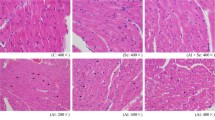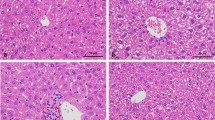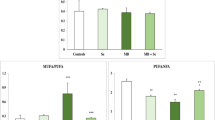Abstract
Free radical processes are proposed to play a crucial role in the development of procainamide adverse effects. Therefore, selenium, as a potent antioxidant, may modified procainamide toxicity. To test this hypothesis plasma and liver thiobarbituric acid-reacting substances (TBARS), plasma antioxidant activity (AOA), erythrocyte and liver superoxide dismutase (SOD), catalase, as well as selenium-dependent glutathione peroxidase (Se-GPX) were determined in the following four groups of rats: selenium-treated (Se), procainamide-treated (P), procainamide and selenium-treated (P + Se), and control (C). Morphological studies of leukocytes [tested for lupus erythematosus (LE) cells] and liver were also made. Atypical, i.e. enlarged and swollen, leukocytes resulting from procainamide and selenium treatment were observed. These changes were found in four out of five rats in the Se group, eight out of ten in the P group, and in seven out of ten in the P + Se group. LE-like cells were observed in two rats in the P + Se group. A statistically significant decrease in plasma and liver TBARS by 20% and 36%, respectively, increased activity of SOD by 20%, catalase by 48% and Se-GPX by 15% in erythrocytes, and decreased activity of liver SOD by 17% and catalase by 22% were found in the P + Se group as compared to the P group. These results indicated that selenium exerted antioxidant effects on the procainamide-treated rats. However, selenium did not prevent the development of disturbances in leukocyte morphology, on the contrary, it possibly promoted the conversion of leukocytes to LE cells.
Similar content being viewed by others
References
Aebi HE (1983) Catalase. In: Bergmeyer HU (ed) Methods of enzymatic analysis, vol 3. Verlag Chemie, Weinheim Deerfield Beach Basel, pp 273–286
Adams LE, Roberts SM, Carter JM, Wheeler JF, Zimmer HW, Donovan-Brand RJ, Hess EV (1990) Effects of procainamide hydroxylamine on generation of reactive oxygen species by macrophages and production of cytokines. Int J Immunopharmacol 12: 809–819
Annerén G, Gebre-Medhin M, Gustavson K-H (1989) Increased plasma and erythrocyte glutathione peroxidase activity after selenium supplementation in children with Down syndrome. Acta Paediatr Scand 78: 879–884
Bluestein HG, Weisman MH, Zvaifler NJ, Shapiro RJ (1979) Lymphocyte alteration by procainamide: relation to drug-induced lupus erythematosus syndrome. Lancet II: 816–819
Buege JA, Aust SD (1978) Microsomal lipid peroxidation. In: Colowick SP, Kaplan NO (eds) Methods in enzymology, vol 52. Academic Press, New York San Francisco London, pp 302–324
Combs GF Jr, Combs SB (1987) Selenium effects on drug and foreign compound toxicity. Pharmacol Ther 33: 303–315
Fairris GM, Perkins PJ, Lloyd B, Hinks L, Clayton BE (1989) The effect on atopic dermatitis of supplementation with selenium and vitamin E. Acta Derm Venereol (Stockh) 69: 359–362
Ganther HE (1974) Biochemistry of selenium. In: Zingaro RA, Cooper WC (eds) Selenium. Van Norstrand Reinhold Co, New York Cincinnati Toronto London Melbourne, pp 546–614
Grisham MB, McCord JM (1986) Cytotoxicity of reactive oxygen metabolites. In: Taylor AE, Matalon S, Ward P (eds) Physiology of oxygen radicals. American Physiological Society, Baltimore MD, pp 1–18
Hartree ET (1972) Determination of protein. A modification of the Lowry method that gives a linear response. Anal Biochem 48: 422–427
Kleinman S, Nelson R, Smith L, Goldfinger D (1984) Positive direct antiglobulin tests and immune hemolytic anemia in patients receiving procainamide. N Engl J Med 311: 809–812
Koller LD, Exon JH (1986) The two faces of selenium-deficiency and toxicity-are similar in animals and man. Can J Vet Res 50: 297–306
Larsen RA, Bøyum A (1972) Development of an indirect LE factor test. Acta Med Scand Suppl 543: 21–29
Lawrence RA, Burk RF (1976) Glutathione peroxidase activity in selenium-deficient rat liver. Biochem Biophys Res Commun 71: 952–958
LeBoeuf RA, Laishes BA, Hoekstra WG (1985) Effects of dietary selenium concentration on the development of enzyme-altered liver foci and hepatocellular carcinoma induced by diethylnitrosamine in rats. Cancer Res 45: 5489–5495
Levander OA (1987) A global view of human selenium nutrition. Annu Rev Nutr 7: 227–250
Luoma PV, Sotaniemi EA, Korpela H, Kupulainen J (1984) Serum selenium, glutathione peroxidase activity and high density lipoprotein cholesterol-effect of selenium supplementation. Res Commun Chem Pathol Pharmacol 46: 469–472
Magner-Wróbel K, Toborek M, Drózdz M, Danch A (1993) Increase in antioxidant activity in procainamide-treated rats. Pharmacol Toxicol 72: 94–97
Misra HP, Fridovich I (1972) The role of superoxide anion in the autoxidation of epinephrine: a simple assay for superoxide dismutase. J Biol Chem 247: 3170–3175
Mongey A-B, Hess EV (1989) Drug-related lupus. Curr Opin Rheumatol 1: 353–359
Mongey A-B, Donovan-Brand R, Thomas TJ, Adams LE, Hess EV (1992) Serologic evaluation of patients receiving procainamide. Arthritis Rheum 35: 219–223
O'Dell JR, McGivern JP, Kay HD, Klassen LW (1988) Improved survival in murine lupus as the result of selenium supplementation. Clin Exp Immunol 73: 322–327
Olmsted L, Schrauzer GN, Flores-Arce M, Dowd J (1989) Selenium supplementation of human immunodeficiency virus infected patients. Biol Trace Elem Res 20: 59–65
Petrie HT, Klassen LW, Klassen PS, O'Dell JR, Kay D (1989) Selenium and the immune response: 2. Enhancement of murine cytotoxic T-lymphocyte and natural killer cell cytotoxicity in vivo. J Leukocyte Biol 45: 215–220
Rea HM, Thomson CD, Campbell DR, Robinson MF (1979) Relation between erythrocyte selenium concentrations and glutathione peroxidase (EC 1.11.1.9) activities of New Zealand residents and visitors to New Zealand. Br J Nutr 42: 201–208
Roberts SM, Adams LE, Donovan-Brand R, Budinsky R, Skoulis NP, Zimmer HP, Hess EV (1989) Procainamide hydroxylamine lymphocyte toxicity — I. Evidence for participation by hemoglobin. Int J Immunopharmacol 11: 419–427
Rothman IK, Amorosi EL (1979) Procainamide-induced agranulocytosis and thrombocytopenia. Arch Int Med 139: 246–247
Rubin RL, Curnutte JR (1989) Metabolism of procainamide to the cytotoxic hydroxylamine by neutrophils activated in vitro. J Clin Invest 83: 1336–1343
Rubin RL, Uetrecht JP, Jones JE (1987) Cytotoxicity of oxidative metabolites of procainamide. J Pharmacol Exp Ther 242: 833–841
Shields AF, Berenson JA (1988) Procainamide-associated pancytopenia. Am J Hematol 27: 299–301
Snedecor GW, Cochran WG (1974) Statistical methods, 7th edn. Iowa State University Press, Ames, Iowa
Spallholz JE (1981) Selenium: what role in immunity and immune cytotoxicity? In: Spallholz JE, Martin JL, Ganther HE (eds) Selenium in biology and medicine. AVI Press, Westport Conn. pp 103–117
Spallholz JE, Boylan LM, Larsen HS (1990) Advances in understanding selenium's role in the immune system. Ann NY Acad Sci 587: 123–139
Stocks J, Gutteridge JMC, Sharp RJ, Dormandy TL (1974) Assay using brain homogenate for measuring the antioxidant activity of biological fluids. Clin Sci Molec Med 47: 215–222
Sundstrom H, Korpela H, Sajanti E, Kauppila A (1989) Supplementation with selenium, vitamin E and their combination in gynecological cancer during cytotoxic chemotherapy. Carcinogenesis 10: 273–278
Tarp U, Hansen JC, Overvad K, Thorling EB, Tarp BD (1987) Glutathione peroxidase activity in patients with rheumatoid arthritis and in normal subjects: effects of long-term selenium supplementation. Arthritis Rheum 30: 1162–1166
Thomson CD, Rea HM, Doesburg VM, Robinson MF (1977) Selenium concentrations and glutathione peroxidase activities in whole blood of New Zealand residents. Br J Nutr 37: 457–460
Thompson JF, Robinson CA, Segal JL (1988) Procainamide agranulocytosis: a case report and review of the literature. Curr Ther Res 44: 872–881
Uetrecht J (1990) Drug metabolism by leukocytes and its role in drug-induced lupus and other idiosyncratic drug reactions. Crit Rev Toxicol 20: 213–235
Washulewski IH, Sunde RA (1988 a) Effect of dietary methionine on utilization of tissue selenium from dietary selenomethionine for glutathione peroxidase in the rat. J Nutr 118: 367–374
Washulewski IH, Sunde RA (1988 b) Effect of dietary methionine on tissue selenium and glutathione peroxidase (EC 1.11.1.9) activity in rats given selenomethionine. Br J Nutr 60: 57–68
Author information
Authors and Affiliations
Rights and permissions
About this article
Cite this article
Toborek, M., Magner-Wróbel, K., Drózdz, M. et al. Modulation of procainamide toxicity by selenium-enriched yeast in rats. Arch Toxicol 67, 691–695 (1993). https://doi.org/10.1007/BF01973693
Received:
Accepted:
Issue Date:
DOI: https://doi.org/10.1007/BF01973693




